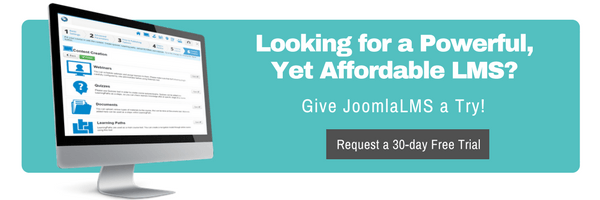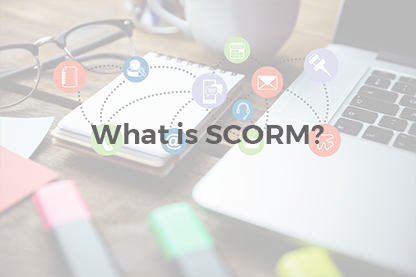The decision to purchase one or another Learning Management System is frequently based on the LMS features available and, therefore, the benefits clients will receive if they purchase a particular LMS solution. The JoomLMS features list is quite long (by the way, Brandon Hall Group called JoomLMS “one of the more robust solutions at this price point” in the research released in September), but what if we tell you that there are even more out-of-the-box LMS features you are most likely unsuspicious of.
Does it sound intriguing?
The decision to purchase one or another Learning Management System is frequently based on the LMS features available and, therefore, the benefits clients will receive if they purchase a particular LMS solution. The JoomLMS features list is quite long (by the way, Brandon Hall Group called JoomLMS “one of the more robust solutions at this price point” in the research released in September), but what if we tell you that there are even more out-of-the-box LMS features you are most likely unsuspicious of.
Does it sound intriguing?
We have collected 14 things you might not know JoomLMS does:
1. Lets you run JoomLMS even if your website is not built on Joomla!
If your website is built on WordPress, Drupal or any other CMS you can still employ JoomLMS as your eLearning solution. JoomLMS will be installed on a Joomla!-based subdomain, the design of which will be adjusted to meet your main website’s look and feel. After that, a link to the subdomain will be added as a new menu item on your current website. That’s it!
2. Lets you create any custom LMS role
JoomLMS Profession version allows creating custom user roles with any set of permissions. Thus, you are not confined to default LMS user roles and can control the types of activities users are allowed to perform and data to work with by including and excluding default user type characteristics and permissions. For example, you can widen the parent’s capabilities by granting access to users and groups and reports (on the basis of a role of a teacher).

3. Displays external links within the LMS pages
To open a link within the LMS layout, simply select “Open in an inline frame” as a location in the link settings. The students will see a third-party website in a frame on the JoomLMS page.
*Please note that some websites block the iframe embedding for security reasons.

4. Secures files from downloading by a direct link
All the files and folders inside the JoomLMS Documents section are safe from accessing and downloading by a direct link. It means that all the data is secure inside JoomLMS and nobody, even a registered user, will have access to the files unless they are granted a respective permission.
5. Releases the LMS lessons sequentially
JoomLMS materials, quizzes and learning paths can be published gradually (X days from the enrollment date), not all at once. The “Time released” option helps you prevent the students from jumping around the course, ensure systematic learning and make students come back to your website when a new lesson is published (additional email reminders can be sent manually).

6. Uses quizzes as surveys and displays the answers in graphs
When you want to gather the students’ opinion on the course or collect the vision of the problem you can create a “multiple choice” question with a set of predefined answers and enable the “Survey question (non-graded)” option.
If the quiz settings allow displaying the quiz results as graphic bars you will be able to view the statistics in a graph format.

7. Lets you upload multiple documents as a ZIP file
To save time on multiple documents upload simply compress the files into a single zip file, upload the zipped file into the Documents section and select “Yes” for the "Automatically extract zips" option.
The documents will be extracted in line with the zipped catalog structure.

8. Deploys a {readmore} option
On any page of the JoomLMS course it is possible to add a {readmore} tag to truncate a long text or display only its short summary. The rest of the content will be displayed when a “read more” link is clicked.
Thus, the course page will look clean and uncluttered.

9. Lets you add any third-party forum tool without customization
If you want to add a forum into the LMS, simply create an additional menu item with a link pointing to the Forum component and assign the JoomLMS template to this very component. You will get forum pages looking the same as the JoomLMS pages. More details on the Forum setup can be found in the blog post JoomLMS Tips: How to Add a Forum to a JoomLMS Site.
10. Lets you rename the titles inside JoomLMS
If you need to change the name of any module, section, user role etc. you can simply override the text constant. To do so, you need to enter Back End – Extensions – Languages – Overrides.

11. Grants free trials to paid courses
Besides the default payment processors integrated into JoomLMS, it is possible to grant students free access to a paid course for a limited period of time. Thus, a student can try a course before making a payment and you can attract more clients.
12. Adds assignments as steps to the learning path
A learning path is a sequence of steps a student needs to go through to pass the course. In the same way you add documents, SCORMs and quizzes into the learning path, you can add assignments.

13. Adds custom Gradebook items
JoomLMS allows adding a variety of items to be manually graded and displayed in the Gradebook. There is a set of default categories available. It is possible to rename those categories at the Back End by double clicking the titles. Thus, you can rename the categories you don’t use into the ones required.

14. Builds custom modules
If there is a need to display additional content on the course home page you can use the custom HTML module. The module represents a blank canvas where you can copy & paste content or create it from scratch (HTML code, images, videos, links etc.). For example, you can create modules with a list of important documents, instructions, additional information about the course or event, upload images, quotes, YouTube or Vimeo videos, external links, contact details etc.

As you can see, JoomLMS is a comprehensive Learning Management System with a lot of not evident LMS features that can bring you a lot of benefits, save your time, effort and money.
If you know more features or JoomLMS workarounds, please share with the readers in the comments below.
What to read next?
10 Reasons to Build Your ELearning Project With JoomLMS [Infographic]
ELearning Project Launch CheckList
JoomLMS and Top WordPress LMSs Comparison









